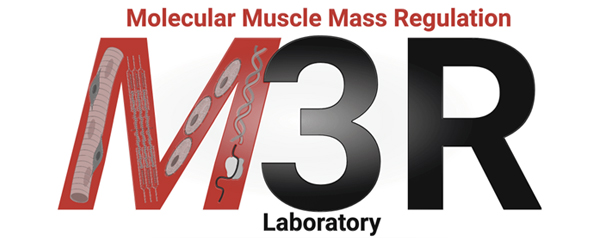The Molecular Muscle Mass Regulation Laboratory (M3R) primarily focuses on the cellular and molecular regulation of skeletal muscle mass throughout the lifespan
Led by Kevin A. Murach, PhD, an Associate Professor in the Department of Health, Human Performance, and Recreation at the University of Arkansas in Fayetteville (USA), the laboratory is housed in the College of Education and Health Professions (COEHP).
To study skeletal muscle mass regulation, the M3R laboratory uses a combination of approaches, including genetically modified mouse models, in vitro experiments involving stem cells and cell lines, human muscle samples, histology, multi-omic analyses, and single-cell and nucleus molecular biology.
Support from AFAR and NIH/NIA
Most recently, the work from the lab has been supported by the Glenn Foundation for Medical Research/American Foundation for Aging Research (AFAR) and the National Institutes of Health (NIH) – National Institute on Aging (NIA) to understand how exercise regulates the epigenetics of aging in skeletal muscle:
https://www.afar.org/grantee-profiles/kevin-murach
https://reporter.nih.gov/search/TNZxikepcEKJeLm4DcYTjQ/project-details/10409969
https://reporter.nih.gov/search/TNZxikepcEKJeLm4DcYTjQ/project-details/10734927
https://reporter.nih.gov/search/TNZxikepcEKJeLm4DcYTjQ/project-details/11137367
Publications
This work thus far has produced several impactful publications related to how exercise affects epigenetics, specifically in skeletal muscle, and how the epigenetic “reprogramming” Yamanaka factor MYC may influence exercise adaptations throughout the lifespan:
Muscle-specific cellular and molecular adaptations to late-life voluntary concurrent exercise
https://academic.oup.com/function/article/3/4/zqac027/6590819
Late-life exercise mitigates skeletal muscle epigenetic aging
https://onlinelibrary.wiley.com/doi/full/10.1111/acel.13527
A molecular signature defining exercise adaptation with ageing and in vivo partial reprogramming in skeletal muscle
https://physoc.onlinelibrary.wiley.com/doi/full/10.1113/JP283836
The 24-hour molecular landscape after exercise in humans reveals MYC is sufficient for muscle growth
https://www.embopress.org/doi/full/10.1038/s44319-024-00299-z
Exercise-induced MYC as an epigenetic reprogramming factor that combats skeletal muscle aging
Making sense of MYC in skeletal muscle: Location, duration, and magnitude
https://journals.physiology.org/doi/prev/20250724-aop/abs/10.1152/ajpcell.00528.2025
Other work pertains to skeletal muscle “memory”, or the idea that skeletal muscle has a mechanism to “remember” a healthier state, which can positively influence future muscle adaptation to exercise:
Muscle memory: myonuclear accretion, maintenance, morphology, and miRNA levels with training and detraining in adult mice
https://onlinelibrary.wiley.com/doi/full/10.1002/jcsm.12617
Nucleus type-specific DNA methylomics reveals epigenetic “memory” of prior adaptation in skeletal muscle
https://academic.oup.com/function/article/2/5/zqab038/6342155
Muscle memory theory: A critical evaluation
https://physoc.onlinelibrary.wiley.com/doi/full/10.1113/JP289597
A third line of inquiry in the M3R laboratory involves understanding how muscle stem cells, or “satellite cells”, can contribute to muscle adaptability throughout the lifespan, and particularly late in life:
A satellite cell-dependent epigenetic fingerprint in skeletal muscle identity genes after lifelong physical activity
https://faseb.onlinelibrary.wiley.com/doi/pdfdirect/10.1096/fj.202500177R
At the nexus between epigenetics and senescence: The effects of senolytic (BI01) administration on DNA methylation clock age and the methylome in aged and regenerated skeletal muscle
https://onlinelibrary.wiley.com/doi/full/10.1111/acel.70068
Satellite cells choreograph an immune cell-fibrogenic cell circuit during mechanical loading in geriatric skeletal muscle
Overall, the work from the M3R lab has produced fundamental information on how skeletal muscle ages as well as adapts to exercise at the cellular and molecular levels. The hope is that this basic understanding can lead to therapeutic approaches that improve muscle health and/or enhance adaptability to exercise throughout the lifespan. Further information about the laboratory can be found here: https://musclemasslab.uark.edu/
Muscle health with exercise and aging podcasts
Dr. Murach’s appearances on podcasts discussing muscle health with exercise and aging can be found here:
https://www.youtube.com/watch?v=vCD5Fct7ZzU
https://www.youtube.com/watch?v=Lmtlo5fioMk
https://www.youtube.com/watch?v=sQ3_dR4IHUY
The College of Education and Health Professions
The College of Education and Health Professions at the University of Arkansas prepares students for a wide range of careers in education and health. The college comprises approximately 360 faculty and staff members, serving more than 6,000 students and supporting over 25 research and service units.
Driven by the WE CARE strategic plan, the college strives to advance impactful research that improves people’s lives, increase transformative learning opportunities for its students, engage in meaningful partnerships across Arkansas and beyond, and embrace a culture of caring that empowers people to thrive in all aspects of life.
The College of Education and Health Professions boasts an extensive research portfolio that is accompanied by multiple large-scale, prestigious grants secured by faculty and staff. Over the past five years, the college has received over $100 million in external funding.



